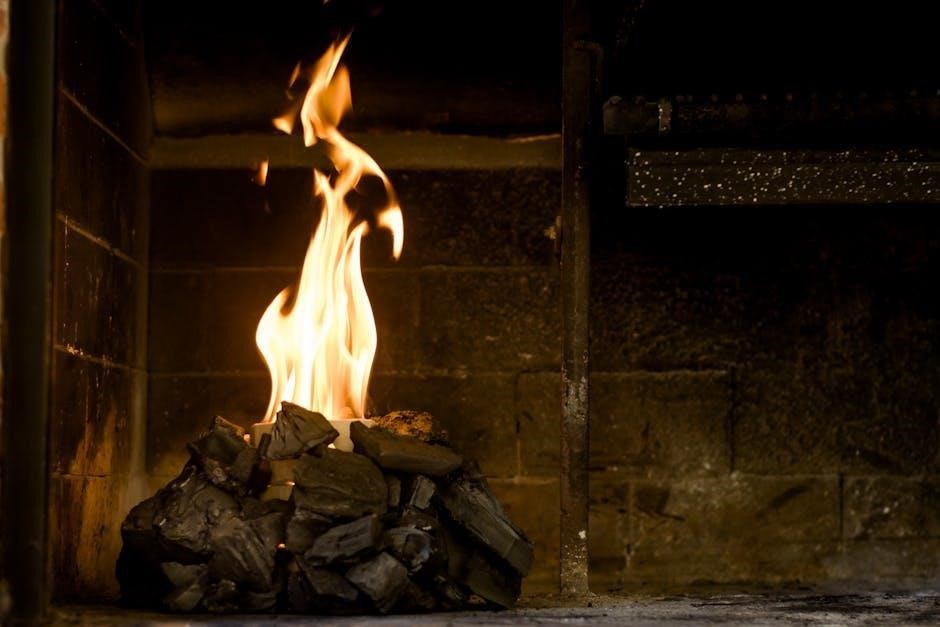Choosing the right size for your fireplace insert is crucial for efficient heating and comfort․ This guide provides a comprehensive overview to help you make the best decision․
Why Choosing the Right Size Matters
Choosing the right size for your fireplace insert is essential for optimal performance, safety, and energy efficiency․ A properly sized insert ensures maximum heat output and minimizes energy waste, while an incorrectly sized one can lead to inefficient heating or safety hazards․ Incorrect sizing may result in poor drafting, reduced efficiency, or even carbon monoxide risks․ A well-fitted insert enhances comfort by providing steady, even heat distribution, avoiding overheating or insufficient warmth․ Additionally, the right size ensures compliance with safety standards and environmental regulations, especially for wood-burning inserts․ Proper sizing also impacts the overall aesthetic appeal, ensuring the insert complements your fireplace and room design․ By selecting the correct size, you ensure a safe, efficient, and enjoyable heating experience for years to come․
Benefits of Properly Sized Fireplace Inserts
A properly sized fireplace insert offers numerous benefits, including enhanced heating efficiency and improved safety․ Correct sizing ensures optimal heat distribution, reducing energy waste and lowering utility bills․ It also minimizes the risk of overheating or insufficient warmth, creating a more comfortable living space․ Properly sized inserts improve airflow, which is crucial for safe and efficient combustion, especially in wood-burning models․ They also reduce environmental impact by burning fuel more cleanly and effectively․ Additionally, the right size ensures a better fit within your fireplace, preserving its structural integrity and aesthetic appeal․ Investing in a well-sized insert provides long-term value, ensuring reliable performance and extending the lifespan of your heating system․ Ultimately, proper sizing enhances both functionality and enjoyment, making it a critical factor in your decision-making process․

Understanding Fireplace Insert Types
Fireplace inserts come in various types, including wood-burning, gas, pellet, and electric models, each offering unique benefits like energy efficiency, low maintenance, and realistic flame effects․
Wood-Burning Fireplace Inserts
Wood-burning fireplace inserts are a popular choice for their traditional charm and eco-friendly appeal․ They use real wood, offering an authentic fire experience while providing efficient heat․ These inserts are ideal for homeowners seeking to reduce reliance on fossil fuels․ Proper sizing is essential to ensure optimal performance and safety․ Consider the moisture content of the wood, as it affects burn efficiency and emissions․ Regular maintenance, such as cleaning the chimney, is crucial to prevent hazards like creosote buildup․ Wood-burning inserts also require proper venting to ensure safe operation․ With the right installation and care, they can be a cost-effective and sustainable heating solution for many years․
Gas Fireplace Inserts
Gas fireplace inserts offer a convenient and efficient alternative to wood-burning models․ They provide consistent heat with minimal maintenance, making them a popular choice for modern homes․ Available in both natural gas and propane options, these inserts are ideal for those seeking ease of use․ Direct vent models are the most common, requiring proper venting for safe operation, while vent-free options are also available for specific installation scenarios․ Sizing is crucial, as the BTU output must align with the room’s dimensions to ensure efficient heating․ Gas inserts are known for their realistic flame presentations and low environmental impact compared to wood-burning alternatives․ They are also more energy-efficient than electric inserts in many cases․ Always consult a professional for installation to ensure safety and optimal performance․
Pellet Fireplace Inserts
Pellet fireplace inserts are an eco-friendly and energy-efficient option, offering a sustainable alternative to traditional wood-burning units․ They burn compressed biomass, such as wood pellets, producing minimal emissions and high combustion efficiency․ These inserts are ideal for smaller spaces or homes with limited ventilation, as they require less airflow compared to wood-burning models․ Proper sizing is essential to ensure optimal performance, with BTU ratings tailored to the room’s dimensions․ Pellet inserts often feature programmable thermostats and remote controls, allowing precise temperature management․ Maintenance involves regular cleaning of the burn pot and venting system to ensure safety and efficiency․ Their compact design and low environmental impact make them a popular choice for homeowners seeking a balance between convenience and sustainability․ Always consider local regulations regarding emissions when selecting a pellet insert for your home․
Electric Fireplace Inserts
Electric fireplace inserts are a modern, low-maintenance alternative to traditional fireplaces․ They offer realistic flame effects using LED technology and provide consistent heat without the need for venting․ These inserts are ideal for homes with limited space or where gas and wood-burning options are impractical․ They are eco-friendly, producing no emissions or pollutants․ Installation is straightforward, as they require only a standard electrical connection․ Electric inserts are highly energy-efficient and come in various styles to suit any decor․ They often feature adjustable heat settings, timers, and remote controls for convenience․ Maintenance is minimal, with no need to clean ash or soot․ Their versatility and ease of use make them a popular choice for homeowners seeking a hassle-free heating solution․ They are also safer than combustion-based inserts, as they operate without open flames or hot surfaces․

Measuring Your Fireplace
Accurate measurements of your fireplace’s width, height, and depth are essential for selecting the right insert size, ensuring proper fit and optimal performance․
How to Measure Fireplace Width

To accurately measure your fireplace width, start by locating the opening of the firebox․ Use a tape measure to span the widest part of the opening horizontally․ Ensure the tape measure is level and straight for precise results․ Record this measurement in inches or centimeters, as it will determine the maximum width of your insert․ If your fireplace has a surround or mantel, measure the inner edge of the surround to ensure the insert fits properly․ Double-check your measurements to avoid errors, as an ill-fitting insert can compromise both safety and efficiency․ Always refer to the manufacturer’s specifications for the recommended insert size based on your fireplace dimensions․
How to Measure Fireplace Height
To measure the height of your fireplace, focus on the interior of the firebox․ Start by positioning a tape measure at the bottom edge of the firebox opening․ Extend the tape measure upward to the highest point of the opening, ensuring it remains straight and level․ Record this measurement in inches or centimeters․ If your fireplace has a surround or decorative trim, measure the inner height to ensure the insert fits seamlessly․ For accuracy, take multiple measurements from different angles and use the smallest dimension to avoid oversizing․ This step is critical as the height determines the insert’s compatibility and ensures proper installation․ Always consult the manufacturer’s guidelines for specific sizing requirements based on your measurements․
How to Measure Fireplace Depth
To measure the depth of your fireplace, focus on the interior of the firebox․ Place a tape measure from the back wall of the firebox to the inner edge of the fireplace opening․ Ensure the tape measure remains straight and level․ Record this measurement in inches or centimeters․ If your fireplace has a surround or decorative trim, measure the inner depth to ensure the insert fits properly․ Take multiple measurements from different angles and use the smallest dimension to avoid oversizing․ This step is crucial as the depth determines the insert’s compatibility and ensures proper installation․ Always consult the manufacturer’s guidelines for specific sizing requirements based on your measurements․

Room Size and Layout Considerations
Room size and layout significantly impact heating efficiency․ Larger spaces require more powerful inserts, while smaller rooms need smaller units to maintain comfort․ Consider furniture placement, window placement, and ceiling height when selecting an insert size to ensure optimal heat distribution and energy efficiency․
Calculating Room Size for Heating Needs
Calculating your room’s size is essential to determine the appropriate fireplace insert size․ Measure the room’s length, width, and height to calculate its cubic footage․ Consider insulation quality, window placement, and ceiling height, as these factors influence heat retention․ Rooms with high ceilings or large windows may require higher BTU-rated inserts to maintain warmth․ Additionally, the number of occupants and desired temperature play a role in heating needs․ A larger room typically requires a more powerful insert, while smaller spaces may be efficiently heated with a smaller unit․ Ensure the insert’s BTU rating matches your room’s dimensions for optimal performance․ Consulting a professional can help tailor the insert size to your specific space and heating requirements․
How Room Layout Affects Heat Distribution
Room layout significantly impacts how heat from your fireplace insert is distributed․ Furniture placement, obstacles, and open spaces influence airflow and warmth circulation․ Large objects or walls can block heat, creating cold spots, while open layouts allow heat to spread evenly․ Direct venting or fans can enhance distribution, ensuring warmth reaches all areas; Strategic placement of the insert, such as avoiding corners, maximizes heat flow․ Consider positioning furniture to allow unobstructed airflow for optimal comfort․ Proper arrangement ensures efficient heating and a cozy environment, making your space more enjoyable year-round․

Factors Influencing Insert Size
Chimney size, venting requirements, insulation, window placement, and fuel moisture content are key factors influencing the optimal size of your fireplace insert․
Chimney Size and Venting Requirements
The size and type of your chimney play a critical role in determining the appropriate fireplace insert size․ A properly sized chimney ensures efficient venting of gases and optimal performance․ Most chimneys come in standard sizes, such as 60 cm or 90 cm, which must align with the insert’s venting requirements․ For instance, a two-burner stove typically pairs with a 60 cm-wide chimney․ Incorrect measurements can lead to poor performance or safety hazards․ Additionally, venting requirements vary by fuel type, with wood-burning inserts often needing larger chimneys compared to gas or pellet inserts․ Ensuring compatibility between your chimney and insert is essential for proper installation and functionality․ Consulting a professional can help you navigate these specifications and ensure compliance with safety standards․
Insulation and Window Placement
Insulation and window placement significantly impact the performance of your fireplace insert․ Well-insulated rooms retain heat more effectively, allowing a smaller insert to provide sufficient warmth․ Conversely, homes with poor insulation may require a larger insert to compensate for heat loss․ Additionally, the placement and size of windows influence heat distribution․ Large windows can lead to heat loss, necessitating a higher BTU output from the insert․ Consider the number and placement of windows when calculating your heating needs․ Strategic placement of the insert relative to windows can also enhance heat circulation․ Ensuring proper insulation and assessing window placement are key steps in selecting the right-sized insert for efficient heating and energy savings․
Moisture Content of Fuel (for Wood-Burning Inserts)
The moisture content of fuel is a critical factor for wood-burning fireplace inserts, as it directly impacts efficiency and performance․ Wood with high moisture content burns less efficiently, producing less heat and potentially causing creosote buildup in the chimney․ Ideally, firewood should have a moisture content of 20% or lower for optimal burning․ Seasoned wood, which has been dried for at least six months, is recommended․ Higher moisture content can lead to incomplete combustion, reducing the insert’s heating capacity and increasing maintenance needs․ Always check the moisture levels of your fuel to ensure your insert operates safely and effectively․ Properly storing wood in a dry, well-ventilated area can help maintain its quality and performance․

Heat Output and Efficiency
Heat output and efficiency are vital for maximizing your fireplace insert’s performance․ Proper sizing ensures optimal heat distribution while maintaining energy efficiency, essential for cost-effective heating solutions․
Understanding BTU Ratings
BTU (British Thermal Units) measures the energy required to heat your space․ Fireplace inserts with higher BTU ratings produce more heat, making them suitable for larger rooms․ To determine the right BTU for your home, calculate your room’s cubic footage and consider insulation quality, window placement, and desired temperature․ A general rule is 20-40 BTU per square foot, but this varies based on factors like ceiling height and external walls․ Proper sizing ensures efficient heating without wasting energy or underheating․ Always match BTU ratings to your room’s specific needs for optimal performance and comfort․
Matching BTU to Room Size
Matching BTU ratings to your room size ensures efficient heating․ Calculate your room’s cubic footage by multiplying length, width, and ceiling height․ A general rule is 20-40 BTU per square foot, but adjust based on factors like insulation quality, window placement, and desired temperature․ For example, a well-insulated room with few windows may require fewer BTUs, while a drafty room with high ceilings may need more․ Consider the fireplace insert’s maximum BTU output and ensure it aligns with your room’s heating needs․ Proper sizing prevents overheating or underheating, ensuring comfort and energy efficiency․ Always consult the manufacturer’s guidelines for specific recommendations tailored to your space․
Efficiency Ratings Explained
Efficiency ratings for fireplace inserts measure how effectively they convert fuel into usable heat․ For gas inserts, Annual Fuel Utilization Efficiency (AFUE) is key, with higher percentages indicating better efficiency․ Wood-burning inserts are rated by EPA certification, ensuring they meet emissions standards․ Pellet inserts often boast high efficiency due to advanced combustion technology․ Electric inserts are inherently efficient since they convert nearly all electricity into heat․ Efficiency depends on factors like fuel type, design, and insulation․ Higher-rated inserts reduce energy costs and environmental impact․ Always check the manufacturer’s specifications and look for certifications to ensure optimal performance․ Proper sizing and installation further enhance efficiency, making it crucial to match the insert to your space and heating needs․

Installation and Maintenance
Installation and maintenance are crucial for optimal performance and safety․ Professional installation ensures proper venting and setup, while regular cleaning and inspections maintain efficiency and prevent hazards․
Professional Installation Recommendations

Hiring a professional to install your fireplace insert is highly recommended to ensure safety and efficiency․ A professional will assess your space, measure your fireplace, and determine the best placement for optimal performance․ They will also handle venting requirements, ensuring proper airflow and compliance with local building codes․ Incorrect installation can lead to poor heating efficiency, safety hazards, or even damage to your home․ Professionals have the expertise to navigate complex setups, such as masonry fireplaces or unique configurations․ Additionally, they can provide guidance on maintenance and operation, ensuring your insert runs smoothly for years to come․ Don’t risk costly mistakes—trust a certified installer to get the job done right․
DIY Installation Tips
If you’re considering a DIY installation, proper preparation is key․ Start by measuring your fireplace accurately to ensure your insert fits perfectly․ Always follow the manufacturer’s instructions and local building codes․ Gather necessary tools, such as a tarp to protect your floor and safety gear like gloves and goggles․ Carefully handle the insert to avoid damage and position it correctly within the fireplace opening․ Use a level to ensure it’s properly aligned․ For venting, follow the manufacturer’s specifications to avoid installation errors․ Double-check all connections before sealing․ While DIY can save money, consider your skill level and safety concerns․ If unsure, consult a professional to avoid potential risks or costly corrections․
Regular Maintenance for Optimal Performance
Regular maintenance is essential to ensure your fireplace insert operates efficiently and safely․ Clean the insert and chimney annually to remove soot and creosote buildup, which can hinder performance․ Inspect the venting system for blockages or damage, as proper airflow is critical for combustion․ Check for wear and tear on seals, gaskets, and other components, replacing them as needed․ For wood-burning inserts, ensure the chimney cap is clear and functional․ Schedule professional inspections every few years to catch potential issues early․ Keep the surrounding area clear of flammable materials and store fuel properly․ Clean glass doors regularly for better visibility․ By maintaining your insert, you’ll enjoy consistent heat, improved efficiency, and a longer lifespan for your unit․

Environmental and Safety Considerations
Fireplace inserts impact the environment and require safety precautions․ Choose eco-friendly fuel options and ensure proper venting to minimize emissions․ Always follow safety guidelines and local regulations․
Environmental Impact of Different Fuel Types
When selecting a fireplace insert, the environmental impact of the fuel type is a critical consideration․ Wood-burning inserts release emissions, contributing to air pollution, while gas inserts produce fewer emissions but still rely on fossil fuels․ Pellet inserts, burning compressed biomass, are more eco-friendly but require sustainable sourcing․ Electric inserts are emission-free and environmentally neutral, depending on the electricity source․ Considering local regulations and environmental goals is essential․ Proper installation and maintenance can minimize ecological effects․ Choose a fuel type that aligns with your environmental values and complies with regional standards for a greener heating solution․
Safety Guidelines for Fireplace Inserts
Ensuring safety is paramount when installing and operating fireplace inserts․ Always hire a professional for installation to meet local codes and safety standards․ Keep flammable materials like curtains or furniture away from the insert․ Regularly inspect the chimney and venting system for blockages or damage․ For wood-burning inserts, store fuel in a dry, well-ventilated area to reduce fire risks․ Gas inserts require proper venting to prevent carbon monoxide buildup․ Electric inserts should be placed away from water sources․ Never leave a burning fire unattended, especially around children or pets․ Clean and maintain your insert regularly to prevent creosote buildup and ensure optimal performance․ By following these guidelines, you can enjoy a safe and cozy heating experience․
Local Regulations and Compliance
Before installing a fireplace insert, it’s essential to check local regulations and ensure compliance․ Many areas have specific requirements for emissions, venting, and fuel types․ Wood-burning inserts, for example, may be subject to strict environmental regulations, especially in regions with air quality concerns․ Some locations might require permits or inspections before installation․ Additionally, certain fuels, like wet or treated wood, may be banned due to environmental impact․ Always consult local authorities to understand the rules in your area․ Compliance not only ensures safety but also avoids potential fines or legal issues․ Professional installers are often well-versed in these regulations and can guide you through the process seamlessly․
Selecting the right fireplace insert size ensures efficient heating, aesthetic appeal, and safety․ Proper sizing enhances comfort while meeting your home’s specific needs and preferences effectively․
Final Tips for Choosing the Right Insert
When selecting a fireplace insert, ensure accurate measurements of your fireplace dimensions to guarantee a proper fit․ Consider your heating needs, room size, and desired aesthetic․ Research different fuel types (wood, gas, pellet, electric) to align with your lifestyle and environmental preferences․ Check local regulations for emissions and safety standards․ Evaluate BTU ratings to match your space’s heating requirements․ Don’t overlook the importance of insulation and venting for optimal performance․ Take your time to compare brands, features, and warranties․ If unsure, consult a professional installer for personalized recommendations․ Proper installation and regular maintenance are key to long-term efficiency and safety․ By thoughtfully considering these factors, you’ll find the perfect insert to enhance your home’s warmth and ambiance․
Common Mistakes to Avoid
When selecting a fireplace insert, avoid common pitfalls to ensure optimal performance and safety․ One major mistake is improper sizing, which can lead to inefficient heating or poor fit․ Another error is ignoring room layout, as furniture placement affects heat distribution․ Some homeowners overlook local regulations, risking non-compliance․ Additionally, failing to consider chimney size and venting requirements can cause installation issues․ Choosing the wrong fuel type for your lifestyle is another frequent oversight․ Lastly, many attempt DIY installation without proper expertise, leading to potential safety hazards․ To avoid these mistakes, measure accurately, consult professionals, and research thoroughly․ Proper planning ensures a safe, efficient, and enjoyable fireplace experience․